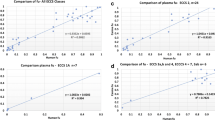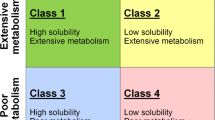Abstract
Purpose. To compare the oral absorption and bioavailability of numerous drugs with a wide variety of physicochemical and pharmacological properties between humans and monkeys and to explore potential reasons for the findings.
Methods. Data for fraction of dose absorbed (F a) and oral absolute bioavailability (F) were obtained by an extensive Medline database search. Inclusion and exclusion criteria were the same as those reported in our previous studies. A total of 43 and 35 drugs were selected for F a and F comparison, respectively. The time to reach peak concentration (t max), total clearance, and nonrenal clearance were evaluated for 15, 28, and 13 drugs, respectively.
Results. F a values in monkeys were similar or identical to those in humans. Additionally, similar t max values were seen in monkeys and humans at comparable doses, thus indicating comparable absorption kinetics between the two species. Conversely, F values in monkeys were generally lower with coumarin being a marked exception. Both total and nonrenal clearances were evaluated and found to be generally greater in monkeys, supporting a generally higher first-pass metabolism and lower F in this species. This was also supported by published data suggesting greater in vitro hepatic drug metabolism for monkeys as compared to humans.
Conclusions. Monkeys appear to be a good predictor of F a in humans. However, a generally lower F makes monkeys a potentially poor predictor of human F. Higher reported metabolic clearances and hepatic enzyme activities in monkeys may account for this observation.
Similar content being viewed by others
REFERENCES
B. Clark and D. A. Smith. Pharmacokinetics and toxicity testing. Crit. Rev. Toxicol. 12:343–385 (1984).
J. H. Lin. Species similarities and differences in pharmacokinetics. Drug Metab. Dispos. 23:1008–1020 (1995).
R. M. Feng, X. Lou, R. R. Brown, and A. Hutchaleelaha. Allometric pharmacokinetic scaling: Towards the prediction of human oral pharmacokinetics. Pharm. Res. 17:410–418 (2000).
W. L. Chiou. Commentary: The rate and extent of oral bioavailability vs. the rate and extent of oral absorption: Classification and recommendation of terminology. J. Pharmacokinet. Pharmacodyn. 28:3–6 (2001).
W. L. Chiou and A. Barve. Linear correlation of the fraction of oral dose absorbed of 64 drugs between humans and rats. Pharm. Res. 15:1792–1795 (1998).
W. L. Chiou, C. Ma, S. M. Chung, Y. H. Jeong, and T. C. Wu. Similarity in the linear and non-linear oral absorption of drugs between human and rat. Int. J. Clin. Pharmacol. Ther. 38:532–539 (2000).
W. L. Chiou, Y. H. Jeong, S. M. Chung, and T. C. Wu. Evaluation of dog as an animal model to study the fraction of oral dose absorbed for 43 drugs in humans. Pharm. Res. 17:135–140 (2000).
J. C. Stevens, L. A. Shipley, J. R. Cashman, M. Vandenbranden, and S. A. Wrighton. Comparison of human and rhesus monkey in vitro phase I and phase II hepatic drug metabolism activities. Drug Metab. Dispos. 5:753–760 (1993).
J. E. Sharer, L. A. Shipley, M. R. Vandenbraden, S. N. Binkley, and S. A. Wrighton. Comparison of phase I and phase II in vitro hepatic enzyme activities of human, dog, rhesus monkey, and cynomolgus monkey. Drug Metab. Dispos. 23:1231–1241 (1995).
W. K. Sietsema. The absolute oral bioavailability of selected drugs. Int. J. Clin. Pharmacol. Ther. Toxicol. 27:179–211 (1989).
L. Z. Benet. S. Øie and J. B. Schwartz. Design and optimization of dosage regimines: Pharmacokinetic data. In A. Goodman-Gilman, J. G. Hardman, L. E. Limbard, P. B. Molinoff, and R. W. Ruddon (eds.), Goodman and Gilman's The Pharmacological Basis of Therapeutics, 9th edition, McGraw-Hill, New York, 1996, pp. 1707–1792.
Physician's Desk Reference, Medical Economics Company, Monvale, New Jersey, 2001.
M. Gibaldi and D. Perrier. Pharmacokinetics, Marcel Dekker, New York, 1982.
W. L. Chiou. Commentary: We may not measure the correct wall permeability coefficient of drugs: Alternative absorptive clearance concept. J. Pharmacokinet. Biopharm. 23:323–343 (1996).
W. L. Chiou. Commentary: New perspectives on the theory of of permeability and resistance in the study of drug absorption and transport. J. Pharmacokinet. Biopharm. 24:433–442 (1997).
T. T. Kararli. Comparison of the gastrointestinal anatomy, physiology, and biochemistry of humans and commonly used laboratory animals. Biopharm. Drug Dispos. 16:351–380 (1995).
E. Chen, Z. Chen, and J. Bielawski. Prediction of oral absorption rate constant in human from in vivo rat data-applications to interspecies scaling and first-dose in man study optimization. J. Pharm. Sci. (Suppl. 1) 1:S–599 (1998).
S. Tannenbaum, H. Boxenbaum, and M. Mayersohn. Allometric analysis of organ extraction ratios. J. Pharm. Sci. 86:1319–1320 (1997).
N. J. Haskins, K. A. Waddell, G. C. Ford, P. N. Spalton, C. M. Walls, T. J. Forrest, and R. F. Palmer. The absorption of disopyramide in animals determined using a stable isotope coadministration technique. Biomed. Mass Spectrom. 7:80–83 (1980).
S. R. Howell, G. E. Husbands, J. A. Scatina, and S. F. Sisenwine. Metabolic disposition of 14C-venlafaxine in mouse, rat, dog, rhesus monkey and man. Xenobiotica 23:349–359 (1993).
S. R. Howell, D. R. Hicks, J. A. Scatina, and S. F. Sisenwine. Pharmacokinetics of venlafaxine and O-desmethylvenlafaxine in laboratory animals. Xenobiotica 24:315–327 (1994).
T. Kuroda, K. Namba, T. Torimaru, K. Kawashima, and M. Hayashi. Species differences in oral bioavailability of methotrexate between rats and monkeys. Biol. Pharm. Bull. 23:334–338 (2000).
A. Durand. J. P. Thénot, G. Bianchetti, and P. L. Morselli. Comparative pharmacokinetic profile of two imidazopyridine drugs: zolpidem and alpidem. Drug Metab. Rev. 24:239–266 (1992).
W. Krause and G. Kühne. Pharmacokinetics of rolipram in the rhesus and cynomolgus monkeys, the rat and the rabbit. Studies on species differences. Xenobiotica 18:561–571 (1988).
W. Krause, G. Kühne, U. Jakobs, and G. A. Hoyer. Biotransformation of the antidepressant D,L-rolipram. I. Isolation and identification of metabolites from rat, monkey, and human urine. Drug Metab. Dispos. 21:682–689 (1993).
W. Krause and G. Kühne. Biotransformation of the antidepressant D,L-rolipram. II. Metabolite patterns in man, rat, rabbit, rhesus and cynomolgus monkey. Xenobiotica 23:1277–1288 (1993).
T. Shimada, M. Mimura, K. Inoue, S. Nakamura, H. Oda, S. Ohmori, and H. Yamazaki. Cytochrome P450-dependent drug oxidation activities in liver microsomes of various animal species including rats, guinea pigs, dogs, monkeys and humans. Arch. Toxicol. 71:401–408 (1997).
J. H. Lin, M. Chiba, S. K. BalaniI, W. Chen, G. Y. Kwei, K. J. Vastag, and J. A. Nishime. Species differences in the pharmacokinetics and metabolism of indinavir, a potent human immunodeficiency virus protease inhibitor. Drug Metab. Dispos. 24:1111–1120 (1996).
L. Prichard, G. Gillet, C. Bonfils, J. Domergue, J. P. Thénot, and P. Maurel. Oxidative metabolism of zolpidem by human liver cytochrome P450s. Drug Metab. Dispos. 23:1253–1262 (1995).
M. Chiba, J. A. Nishime, W. Neway, Y. Lin and J. H. Lin. Comparative in vitro metabolism of indinavir in primates—a unique stereoselective hydroxylation in monkey. Xenobiotica 30:117–129 (2000).
W. A. Ritschel, K. A. Hoffmann, H. S. Tan, and P. R. Sanders. Pharmacokinetics of coumarin upon i.v. administration in man. Arzneimittelforschung 26:1382–1387 (1976).
W. A. Ritschel, D. D. Denson, and K. W. Grummich. Pharmacokinetics of coumarin and 7-hydroxycoumarin in the rhesus monkey after intravenous and peroral administration. Arzneimittelforschung 38:1619–1623 (1988).
W. A. Ritschel, N. N. Vachharajani, R. D. Johnson, and A. S. Hussain. Interspecies scaling of the pharmacokinetic parameters of coumarin among six different mammalian species. Methods Find. Exp. Clin. Pharmacol. 13:697–702 (1991).
Author information
Authors and Affiliations
Corresponding author
Rights and permissions
About this article
Cite this article
Chiou, W.L., Buehler, P.W. Comparison of Oral Absorption and Bioavailability of Drugs Between Monkey and Human. Pharm Res 19, 868–874 (2002). https://doi.org/10.1023/A:1016169202830
Issue Date:
DOI: https://doi.org/10.1023/A:1016169202830




